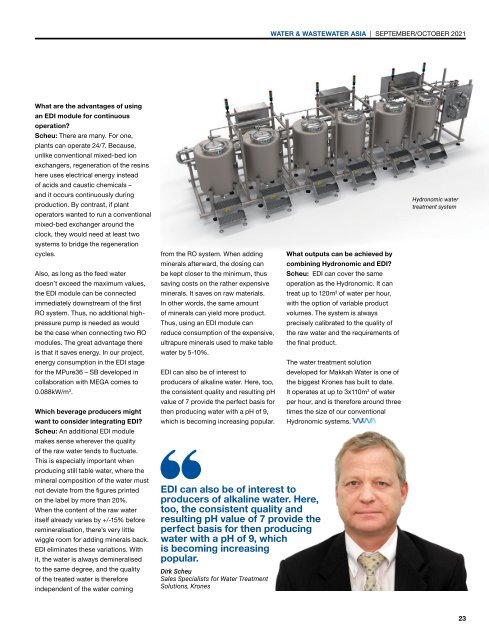Water & Wastewater Asia September/October 2021
Water & Wastewater Asia is an expert source of industry information, cementing its position as an indispensable tool for trade professionals in the water and wastewater industry. As the most reliable publication in the region, industry experts turn this premium journal for credible journalism and exclusive insight provided by fellow industry professionals. Water & Wastewater Asia incorporates the official newsletter of the Singapore Water Association (SWA).
Water & Wastewater Asia is an expert source of industry information, cementing its position as an indispensable tool for trade professionals in the water and wastewater industry. As the most reliable publication in the region, industry experts turn this premium journal for credible journalism and exclusive insight provided by fellow industry professionals. Water & Wastewater Asia incorporates the official newsletter of the Singapore Water Association (SWA).
Create successful ePaper yourself
Turn your PDF publications into a flip-book with our unique Google optimized e-Paper software.
WATER & WASTEWATER ASIA | SEPTEMBER/OCTOBER <strong>2021</strong><br />
What are the advantages of using<br />
an EDI module for continuous<br />
operation?<br />
Scheu: There are many. For one,<br />
plants can operate 24/7. Because,<br />
unlike conventional mixed-bed ion<br />
exchangers, regeneration of the resins<br />
here uses electrical energy instead<br />
of acids and caustic chemicals –<br />
and it occurs continuously during<br />
production. By contrast, if plant<br />
operators wanted to run a conventional<br />
mixed-bed exchanger around the<br />
clock, they would need at least two<br />
systems to bridge the regeneration<br />
cycles.<br />
Also, as long as the feed water<br />
doesn’t exceed the maximum values,<br />
the EDI module can be connected<br />
immediately downstream of the first<br />
RO system. Thus, no additional highpressure<br />
pump is needed as would<br />
be the case when connecting two RO<br />
modules. The great advantage there<br />
is that it saves energy. In our project,<br />
energy consumption in the EDI stage<br />
for the MPure36 – SB developed in<br />
collaboration with MEGA comes to<br />
0.088kW/m 3 .<br />
Which beverage producers might<br />
want to consider integrating EDI?<br />
Scheu: An additional EDI module<br />
makes sense wherever the quality<br />
of the raw water tends to fluctuate.<br />
This is especially important when<br />
producing still table water, where the<br />
mineral composition of the water must<br />
not deviate from the figures printed<br />
on the label by more than 20%.<br />
When the content of the raw water<br />
itself already varies by +/-15% before<br />
remineralisation, there’s very little<br />
wiggle room for adding minerals back.<br />
EDI eliminates these variations. With<br />
it, the water is always demineralised<br />
to the same degree, and the quality<br />
of the treated water is therefore<br />
independent of the water coming<br />
from the RO system. When adding<br />
minerals afterward, the dosing can<br />
be kept closer to the minimum, thus<br />
saving costs on the rather expensive<br />
minerals. It saves on raw materials.<br />
In other words, the same amount<br />
of minerals can yield more product.<br />
Thus, using an EDI module can<br />
reduce consumption of the expensive,<br />
ultrapure minerals used to make table<br />
water by 5-10%.<br />
EDI can also be of interest to<br />
producers of alkaline water. Here, too,<br />
the consistent quality and resulting pH<br />
value of 7 provide the perfect basis for<br />
then producing water with a pH of 9,<br />
which is becoming increasing popular.<br />
What outputs can be achieved by<br />
combining Hydronomic and EDI?<br />
Scheu: EDI can cover the same<br />
operation as the Hydronomic. It can<br />
treat up to 120m 3 of water per hour,<br />
with the option of variable product<br />
volumes. The system is always<br />
precisely calibrated to the quality of<br />
the raw water and the requirements of<br />
the final product.<br />
The water treatment solution<br />
developed for Makkah <strong>Water</strong> is one of<br />
the biggest Krones has built to date.<br />
It operates at up to 3x110m 3 of water<br />
per hour, and is therefore around three<br />
times the size of our conventional<br />
Hydronomic systems.<br />
EDI can also be of interest to<br />
producers of alkaline water. Here,<br />
too, the consistent quality and<br />
resulting pH value of 7 provide the<br />
perfect basis for then producing<br />
water with a pH of 9, which<br />
is becoming increasing<br />
popular.<br />
Dirk Scheu<br />
Sales Specialists for <strong>Water</strong> Treatment<br />
Solutions, Krones<br />
Hydronomic water<br />
treatment system<br />
23


















